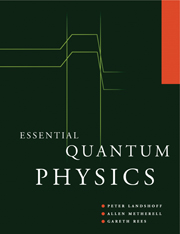Book contents
- Frontmatter
- Contents
- Preface
- Constants of quantum physics
- 1 Preliminaries
- 2 The Schrödinger equation
- 3 Special solutions
- 4 The superposition principle
- 5 The hydrogen atom
- Revision quiz
- 6 The hydrogen molecule
- 7 Introduction to perturbation theory
- 8 Spin
- 9 Masers and lasers
- 10 Band structure of crystals
- 11 Electron motion in crystals
- 12 Transistors
- Appendices
- Hints for the problems
- Index
9 - Masers and lasers
Published online by Cambridge University Press: 05 June 2012
- Frontmatter
- Contents
- Preface
- Constants of quantum physics
- 1 Preliminaries
- 2 The Schrödinger equation
- 3 Special solutions
- 4 The superposition principle
- 5 The hydrogen atom
- Revision quiz
- 6 The hydrogen molecule
- 7 Introduction to perturbation theory
- 8 Spin
- 9 Masers and lasers
- 10 Band structure of crystals
- 11 Electron motion in crystals
- 12 Transistors
- Appendices
- Hints for the problems
- Index
Summary
Radiative transitions
When a system changes its energy as the result of the emission or the absorption of a photon, it is said to undergo radiative transition. There are three kinds of radiative transition. In the presence of an electromagnetic field the system can absorb a photon, so that its energy is raised to a higher level. If the system is initially in a state other than the ground state, it can emit a photon and so shed energy. This can happen without the presence of any external electromagnetic field, in which case a spontaneous emission is said to occur. On the other hand, if the excited system is placed in an electromagnetic field that varies in time with the appropriate frequency, the probability that it will emit a photon can be greatly enhanced. In this case the emission process is known as stimulated emission. Stimulated emission is the basis of maser and laser action, which we describe in this chapter.
First, we construct a simple model that allows us to investigate how the internal structure of a quantum system changes as the result of a radiative transition. Although the model is very simple, it will allow us to understand the main features of the proper, more exact treatment. We shall deal mainly with absorption and stimulated emission, the two types of radiative transition where there is an external electromagnetic field.
Information
- Type
- Chapter
- Information
- Essential Quantum Physics , pp. 93 - 111Publisher: Cambridge University PressPrint publication year: 1997
